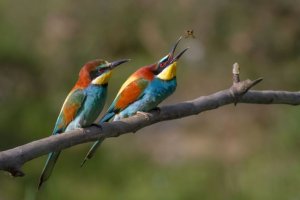
But a bit of perseverance meant that I had views of up to five birds and good views of three Bee-eaters catching large insects – looked like bumblebees but I’m not sure – in good light.
Considering they are the most colourful birds in Europe they were quite easy to miss. I didn’t hear them call which is usually a give-away of their presence, and Bee-eaters are small birds – more sparrow-sized than thrush-sized.
But they were lovely yesterday evening so the journey was well worthwhile. I’ll be heading back when, if, the young fledge and I guess the site will be pretty busy then.
They are well worth a visit if you are in the area between Nottingham and Loughborough – details here.
[registration_form]
So we are loosing Flycatchers and gaining Bee-eaters? We only had one or two flies in the kitchen this year and its ages since we resorted to sticky fly paper to help stem the tide. Is there any evidence of a decline in flies?
andrew – not much fly monitoring goes on – it’s a shame we don’t have a century of data – that would be fascinating.
And flies, not just hoverflies are pollinators.
You probably see more non-syrphid flies than hoverflies on flowers and so i assumed they must be key pollinators but you don’t hear much about it.
A brief look at the Scottish Pollinator Initiative doesn’t seem to mention non-syrphid flies
http://www.biodiversityscotland.gov.uk/news-and-events/news/
It seems that my assumption was right
http://rspb.royalsocietypublishing.org/content/282/1805/20142934
http://www.biodiversityinfocus.com/blog/2015/04/22/whos-really-pollen-their-weight/
Yes Mark, the light is against you in the afternoon/evening so a morning visit would be better.
When we went last week the birds were eating dragonflies (possibly brown hawkers?) as well as ‘bees’ but it seemed to take them ages to finally decide to swallow them. I think they were trying to remove the wings before swallowing the body but I’m not sure they succeeded.
Great birds though (and they did start calling when a kestrel flew into the dead ash branches where they usually gather).
Nick
Nick – the Kestrel and the Ash tree were there yesterday too!